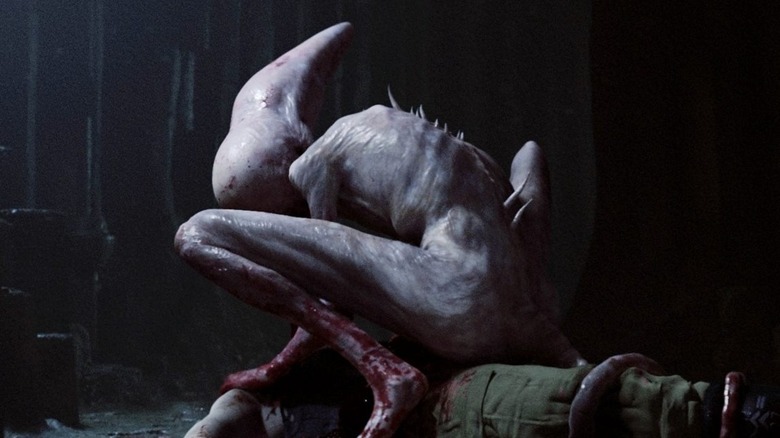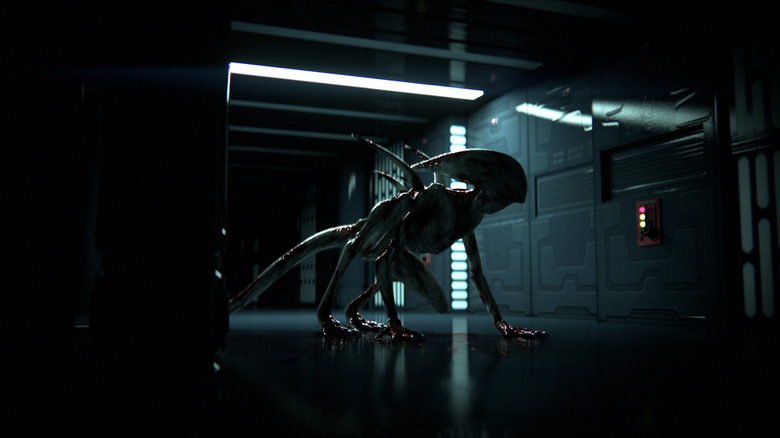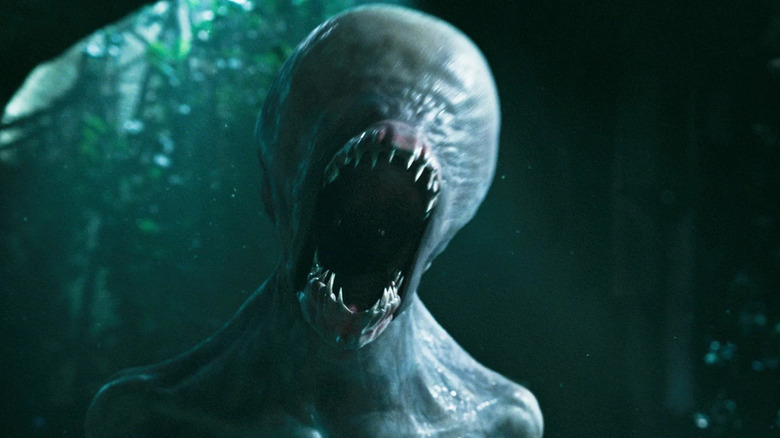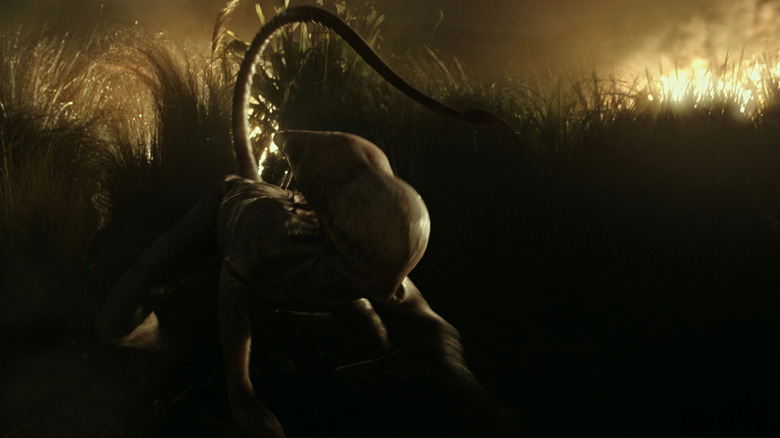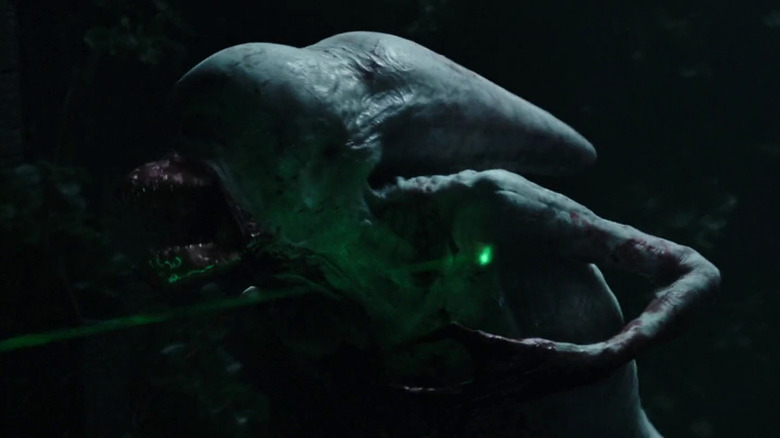Alien: Covenant's Sound Designers Had To Have Strong Stomachs
Ridley Scott's 2017 film "Alien: Covenant," while technically the eighth film in the "Alien" series (if one counts the "Alien vs. Predator" films), is really the third. Scott, when making his 2012 "Alien" prequel "Prometheus," deliberately ignored the mythology introduced in 1986 with James Cameron's "Aliens" — notably, that the alien eggs are laid by a Queen — instead following his own ideas about the series' creatures. By Scott's estimation, Aliens were genetically engineered by an ancient species of towering Engineers who seeded Earth with human DNA billions of years ago. Those same Engineers are now gearing up to wipe out humanity using alien monsters as their extermination tool. This was in response to a grievous act of violence that humanity committed some 2,000 years prior, alluding to the crucifixion of Christ as the potential impetus (!).
Chronologically, "Covenant" follows "Prometheus," but precedes "Alien." In the 2017 film, a rogue android from "Prometheus" named David (Michael Fassbender) has fled to a remote planet where he wiped out the native population of Engineers, and has settled into tinkering with genetics in order to create what he feels is a perfect biological organism: The alien xenomorph. There are no Queens. There is just David.
Much of "Covenant" is devoted to David's creature experiments, and the film contains multiple monsters that can reproduce inside human abdominal cavities. The creatures' appearances are coupled with a lot of growling, clicking, and unutterable alien noises that can barely fit into the human imagination. One's heart can go out to the film's sound designers — Oliver Tarney and Michael Fentum — for inventing such terrifying noises. In a 2017 interview with A Sound Effect, Tarney and Fentum went into detail about the gross sounds they needed to invent for "Covenant."
The Neomorph
One of the more notable creatures in "Covenant" was called, in the script, the Neomorph. Standing at about eight feet, possessed of no facial features other than a puckering, fanged mouth, and sporting an elongated, teardrop-shaped cranium, the Neomorph was a modern spin on the alien from the 1979 film, which was originally designed by Swiss surrealist H.R. Giger. The Neomorph was a skittering, feral beast upon its first appearance, but became disturbingly tame when confronting David.
The Neomorph was a new kind of animal in the Alien universe, and Tarney and Fentum had to come up with a new noise for it to make (it couldn't very well sound like a creature audiences had heard), and were pointed toward a noisy shrimp as guidance. Says Fentum:
"For the Neomorph we began work before we had seen any picture of the creature. There was a video we were given by the picture department of a mantis shrimp that made a loud clicking sound with the note of 'we like this.' So the idea was to somehow incorporate a click or clicking element into the Neo. We sent back some sounds and then waited to see how the creature looked and behaved.
But when the design of the creature came back, they understood that the Neomorph would not be able to make the sounds of a crustacean, nor even be heard through its fast movements. Something new was needed.
A beluga meets splintering wood
Since shrimp were out, Fentum found that Undersea mammals were the next step. What other animals make clicking noises? And would they be able to be heard from a quick moving monster? Fentum found he was getting closer ...
"On seeing the creature there was no real space for a click in its movement as it was so fast, and it was also gelatinous in its texture, so we tried the idea (as it had no eyes) of using clicks as an echolocation tool. We started then trying dolphins and beluga whales which worked for the first temp, but didn't quite cut through enough."
But, as Tarney pointed out, further mixing was needed. Tarney and Fentum used Kyma, a common sound design programming language that allowed for elaborate mixing and sound invention. Using the Kyma, the designers found other non-organic sounds to mix with the organic clicking to find just the right monster voice. Something scary, animal, and yet ... well, alien.
"We started experimenting with blending various elements in the Kyma to see if we could move away from the more familiar dolphin sound, and add a little more agitation and aggression to the sound. One of the sounds that helped when added was a wood fracturing sound that provided a nice resonance. This element really came to life once Mark Taylor started moving it around the room in the FX premix, with delays pinging off the surrounds. It really helped sell the idea of the creature scanning its environment."
Thanks to the sound designers, an important part of the Neomorph's biology was canonically established: It uses echolocation to "see." It's a gelatinous bat dolphin.
What is the sound of one rib thawing?
Although the foley team were not interviewed directly in A Sound Effect, Tarney makes reference to the "Alien: Covenant" team, including foley supervisor Hugo Adams and foley artist Andrea King. They were mentioned for their skill in creating the sounds for the scene where David "tames" the Neomorph. With the creature standing still for the first time, new, lower, meatier, more gurgly noises could be made. Tarney described the rack of thawing ribs required to create the sounds a monster might make, but coming from within:
"We spoke to our foley supervisor, Hugo Adams, about coming up with an element to describe its torso. He bought several frozen racks of ribs which our foley artist, Andrea King, manipulated with a deft touch and a strong stomach. As the racks thawed it got pretty messy, and in the end it was the early takes with the frozen quality that worked the best. Its breaths were created in the Kyma by crossing a bear breathing heavily with a recording of air bubbling through mud, as though it had fluid in its respiratory tract. It helped sell the idea of the Neo being the sickly relative to the Xeno."
Not that many casual viewers have carefully listened to the sound of thawing meat very closely, but wet breathing is likely many have encountered. The Neomorphs sounds were enough to make someone want to clear their own throat. Add enough Kyma manipulation, and a wet bear breathing combined with thawing ribs made something unique.
The baboon scream
Any monster worth their weight in thawing ribs is going to let loose with an animalistic howl when it dives at a still-living human meal. With so many roars and growls throughout monster movie history, coming up with a scary monster roar was going to be a tall order. The only instruction that Tarney and Fentum had received was to make the Neomorph sound like a primate. Anyone who has heard an angry baboon — and watch the 1990 film "Shakma" if you'd like an example — knows that it is indeed a scary sound. Fentum describes how they made a baboon sound alien:
"For the main attack vocal we were given the note that they wanted it to sound like a 'crazed baboon.' We then set about making a large set of agitated creature sounds that we could then manipulate to create the personality Ridley had requested. We used a combination of various creature recordings in the end, including a great recording of an agitated fox I had made, baboons and baby elephants.
One might find that all movie monster roars are mere clever combinations of Earth animals. The Neomorph was a baboon fox elephant. That may be new in the annals of cinema. This technique will have to be repeated until humanity finds real killer aliens. Then foley artists can just record them live.
